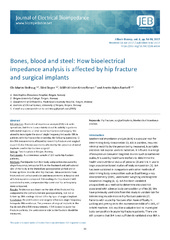Bones, blood and steel: How bioelectrical impedance analysis is affected by hip fracture and surgical implants
Peer reviewed, Journal article
Published version

Åpne
Permanent lenke
https://hdl.handle.net/1956/18224Utgivelsesdato
2017Metadata
Vis full innførselSamlinger
Originalversjon
https://doi.org/10.5617/jeb.4104Sammendrag
Introduction: Bioelectrical impedance analysis (BIA) is in widespread use, but there is uncertainty about its validity in patients with metal implants or after acute hip fracture and surgery. We aimed to investigate the use of single frequency tetrapolar BIA in patients with hip fracture by answering the following questions: 1) Are BIA measurements affected by recent hip fracture and surgical repair? 2) Are BIA measurements affected by the presence of metal implants used in hip fracture surgery? Setting: Two hospitals in Bergen, Norway. Participants: A convenience sample of 203 acute hip fracture patients. Methods: Participants had their body composition measured by single frequency, tetrapolar BIA on the fractured and unfractured side of the body in the immediate postoperative period and at follow-up three months after hip fracture. Measurements from fractured and unfractured side and measurements in hospital and at follow-up were compared. BIA readings for hips treated with cannulated screws, compression hip screw and hip arthroplasty were compared. Results: Resistance was lower on the side of the fractured hip compared to the unfractured side postoperatively, but not at follow-up. BIA readings did not differ by type of surgical implant. Conclusion: Recent fracture and surgery influences single frequency tetrapolar BIA resistance. The presence of surgical implants in the hip do not affect BIA measurements. If BIA is used in acute hip fracture patients, the contralateral side to the fracture should be measured.
